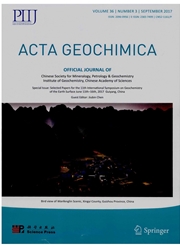

 中文摘要:
中文摘要:
自从中生代,丰富的金属和盐存款在 theLanping 盆被形成了,西方的云南省,西南中国,在中国组成一条著名热水的矿石带。大多数存款是 meso-epithermal 热液矿床。这 paperpreliminarily 由使用磷灰石分裂轨道方法在 Lanping 盆处理热液矿床的矿化作用年龄,并且集成存款和他们的地区性的地质的背景的空间分发,到如下给初步的观点:(1 ) 获得的磷灰石分裂轨道年龄从 19.9 妈到 52.8 妈,他们的主人阶层的比那些年轻的大部分因此他们可以被认为是矿化作用年龄,它代表迟了的矿化作用时期;(2 ) 磷灰石分裂轨道年龄趋于从西方变得更年轻到盆的中间,显示 tectono 液体的最近的进化或中间的盆的 metallogenicprocesses 在西方比那晚结束了;(3 ) 在早第三纪,大多数 theCu 存款在盆的西方的部分被形成;( 4 ),主要 metallogenic 过程发生在早第三纪和晚第三纪之间盆 weresubducted 进的东方、西方的边并且分别地,与它的双边的大陆块碰撞了,中央差错强烈被激活它导致了大规模形成矿石的液体的过程,并且他们的区别和运输因为变化他们的物理并且化学性质。被挤压了并且高举, Lanping 盆变得一内部包含许多种液体的山区的盆套住导致矿床的不同类型的形成(例如, Pb-Zn, Cu, Ag ) 在盆的中间的不同规模。同时,有象 Hg 那样的不稳定的元素的液体, Sb 并且是沿着中央差错系统向上被搬运并且扩散了进它的辅助破裂,因此导致 metallogenic 处理 ofHg, Sb 并且作为在 Lanping 盆的东方合成背斜;(5 ) 并且以后,这些矿床经历了改革和氧化。总结,深巨大的差错在盆,和 metallogenic 是活跃的过程被 tectono 液体的进化在 theLanping 抑制盆。同时, metallogenic 过程的出现做了液体和结构的环境变化的性质,它导致了 fluids.Multi 阶段和 zonational metallogenic 过程回来并且再循环?
 英文摘要:
英文摘要:
Since the Mesozoic, abundant metal and salt deposits have been formed in the Lanping Basin, western Yunnan Province, Southwest China, constituting a well-known hydrothermal ore belt in China. Most of the deposits are meso-epithermal hydrothermal deposits. This paper preliminarily deals with the mineralization ages of hydrothermal deposits in the Lanping Basin by using the apatite fission track method, and integrates the spatial distribution of the deposits and their regional geological backgrounds, to give the preliminary viewpoints as follows: (1) the apatite fission track ages acquired range from 19.9 Ma to 52.8 Ma, much younger than those of their host strata, so they may be considered to be mineralization ages, which represent the late mineralization period; (2) the apatite fission track ages tend to become younger from the west to the middle of the basin, indicating that the latest evolution of tectono-fluid and/or metallogenic processes of the middle basin ended later than that in the west; (3) in the Paleogene, most of the Cu deposits were formed in the western part of the basin; (4) the major metallogenic processes occur between the Paleogene and the Neogene, because the eastern and western edges of the basin were subducted into and collided with its bilateral continental blocks, respectively, and the central fault was strongly activated, which led to the processes of large-scale ore-forming fluids, and their differentiation and transport because of the variation of their physical and chemical properties. Having been squeezed and uplifted, the Lanping Basin became an intermontane basin that contains many kinds of fluid traps resulting in the formation of different types of ore deposits (for example, Pb-Zn, Cu, Ag) of different scales in the middle of the basin. Simultaneously, the fluids with volatile elements such as Hg, Sb and As were transported upwards along the central fault system and diffused into its subordinate fractures, thus leading to the metallogenic processes of Hg, Sb
 同期刊论文项目
同期刊论文项目
 同项目期刊论文
同项目期刊论文
 Cenozoic Evolution of Tectono-fluid and Metallogenic Process in Lanping Basin, Western Yunnan Provin
Cenozoic Evolution of Tectono-fluid and Metallogenic Process in Lanping Basin, Western Yunnan Provin 期刊信息
期刊信息
